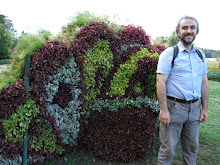marți, 26 mai 2020
duminică, 24 mai 2020
Passing to the limit – towards a Christian hermeneutical approach
The concept of experience itself has its roots in the idea of limit (peira). The traditional key-concepts of empeiria and experientia help us win an understanding about the process of gaining knowledge as progressing, going forward by forging into the limit (H. Maldiney, V. Ciomoş).
In many situations, the border conditions appear decisive for the structural modeling. As a prerequisite for every hermeneutic approach is then the establishing of the limits of the method of research.
By its nature, the limit refers also directly or indirectly at the goal of research and in the same time circumscribes the methodological means to attain it. In the same time, the very concept of definition comes from the Latin finis that means limit (Fr. Pomazansky).
The way of understanding the limit is essential for the architectonic of human knowledge. Fr. Ghelasie considered the human condition as a boundary between the created nature and the divine Prototype of man. The embodied Prototype or Incarnated Limit is the Son of God made flesh, as the sole Interceder in Himself between God and creation.
The Christian Orthodox hermeneutics emphasizes the liturgical dimension of the limit or boundary – place of the “Truth made flesh” or “partaking with Truth”. The mysteries of the Origin and end of time and of this world are interpreted in accord with the specific understanding of the limit.
The models of reality, the paradoxes and antinomies of language, intensive and extensive meanings assigned to the concepts used in an interpretative approach should be consistent with the limits assumed in the respective methodology.
In the Christian view the concept of limit has a transparence and elasticity given by its transcendental roots in the logoi of the created beings assumed in the Person of the Divine Logos.
The limit receives thus a personal modeling or assigning, the ecclesial archetype of limit being the altar made for the intelligible and sensible offering and its transfiguration by the divine Grace.
The unity between the actual form and the contents of knowledge is regulated by the passage to limit understood as the bringing of these contents in communion with Being-as-event (Bakhtin).
The limit as place of an encounter is ever actualized and enriched through dialogue and partaking. The indefinability of the kenotic passage to the limit that allows the transgressing of limitations is inseparable from the „remaining in the limit”, that is, inside the definition (identitary) boundary. That means to remain on the way to the limit.
The concept of limit (with its consistent transgressing) is met by the requirement of consistency and incompleteness of a system of rational knowledge (Gödel). Man’s vocation or calling as a being created in the image of God can be fulfilled by a liturgical passage to limit while remaining into the limit (V. Ciomoş).
According to the patristic teaching, man’s deification does not change his nature, but makes him partaker of the divine energies, assimilated without any loss of identity into the body of Christ. The process is dynamic as the limits are extending together with man’s knowledge and spiritual growth by the action of the divine grace.
Theologically speaking, the limit can be seen as the ever enlarging horizon of knowledge and also as the place of the meeting and partaking between God and creation. The limit expresses here the difference or otherness of the created nature with respect to the divine nature, with the possibility of personal encounter and partaking.
The limit can be understood as an opening or as a closure. The concept of limit is linked with that of the horizon of knowledge that underlies the dynamics of research.
The organization and complexity of a system are coherent with the boundary data that are fundamental for the development of the natural processes and regulate also the possible consistent extensions to a larger perspective and context.
The reductive and prospective approaches have both to do with the idea of limit structurally determined (by the operational and local character specific to outward sciences) or indefinitely projected into the answerable field of the dialogic enfolding of reality.
The problem of limits is thus linked with the reality of personal identity, dialogue and communion.
There are structural and ontological limits. The mystical limit points toward the perichoresis between the immanence and the transcendence, the mystery and its revelation, the apophatic and the cataphatic ways of knowledge.
Florin Caragiu
Abonați-vă la:
Postări (Atom)

